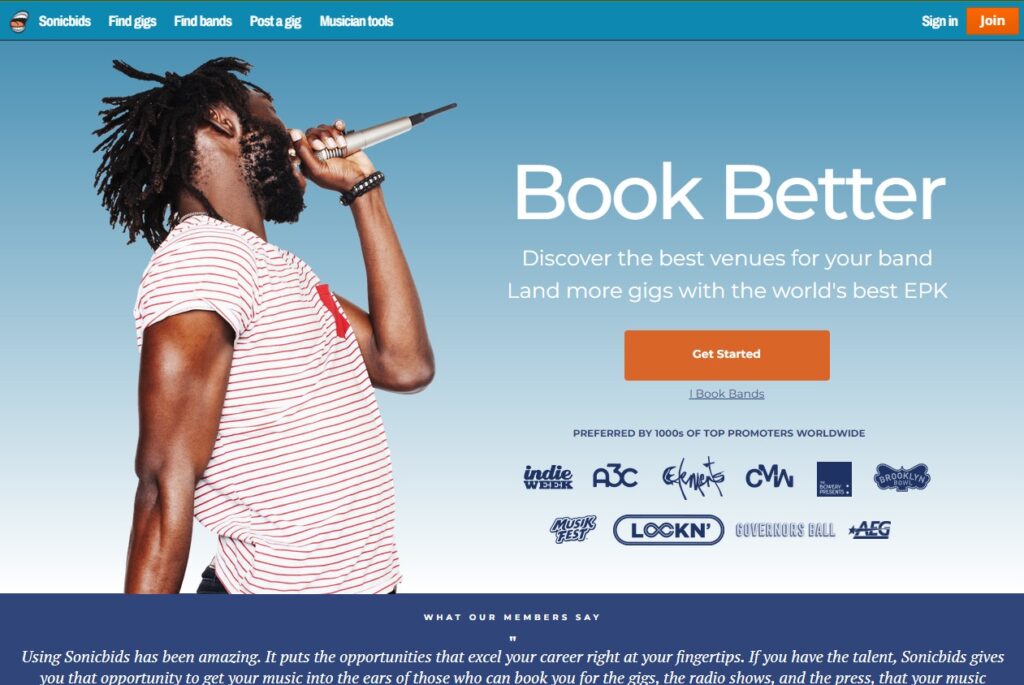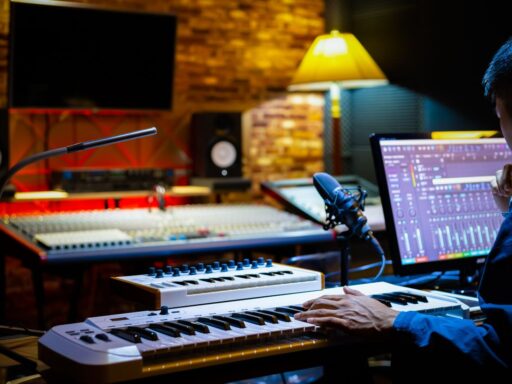Welcome to our Sonicbids guide to master your brand building!
Unlocking Your Unique Sound: The Foundation of Your Brand

As an experienced manager who has represented many artists over the years, I’ve come to understand that at the heart of every successful musician’s brand lies a unique sound.
This signature, once honed and embraced, becomes your most potent marketing tool. In this journey toward unlocking your unique sound, there are several key steps to consider.
Discovering Your Sonic Identity
The first step in unlocking yourunique sound is to embark on a journey of musical self-discovery.
This process involves extensive experimentation and introspection. Listen to a wide range of genres, play with different instruments, and don’t be afraid to step outside your comfort zone.
Over time, you’ll start to notice certain patterns, tones, or styles that resonate more deeply with you.
These elements are thebuilding blocks of your sonic identity. Remember, authenticity is crucial; your sound should be a reflection of your true self, not a mimicry of current trends.
Related Content:Decoding the Playlist Generation (Tailoring Events for the Streaming Era)
Crafting Your Sound
Once you’ve identified the components of your sonic identity, the next step is to refine and combine them into a cohesive sound.
This stage often involves collaboration with producers, other musicians, and vocal coaches, who can provide valuable feedback and help you polish your sound.
Don’t rush this process—developing a unique sound takes time and patience. It’s also important to be open to evolution; your sound may change as you grow as an artist, and that’s perfectly okay.
Embrace these changes as they come, as they are part of your ongoing artistic journey.
Related Content:Master Your Touring Journey: Top Touring Tips for Musicians
Integrating Your Sound into Your Brand
With your sound firmly established, it’s time to integrate it into every aspect of your brand.
This means ensuring that your visual aesthetics, from album, covers to social media posts, resonate with the sonic identity you’ve created.
Your live performances, music videos, and even your personal style should all reinforce your unique sound.
Consistency across all platforms is key to building a strong, recognizable brand.
Additionally, consider how your sound can inform your messaging and the stories you tell through your music.
Every song, album, and performance offers an opportunity to deepen your audience’s connection to your brand.
Unlocking and embracing your unique sound is not just about standing out in a crowded market—it’s about connecting with your audience on a deeper level.
As you continue to evolve and refine your sound, remember that your uniqueness is your greatest asset. Stay true to your artistic vision, and don’t be afraid to let your individuality shine through in everything you do.
Maximizing Exposure: Effective Use of Sonicbids for Brand Building

As an experienced manager who has represented numerous artists over the years, I’ve seen firsthand the transformative power of Sonicbids in brand-building for indie musicians.
Sonicbids offers a unique platform that not only helps artists book gigs but also serves as an invaluable tool for expanding their brand presence both online and offline.
To maximize exposure on this platform, it’s crucial to understand its features and how to effectively leverage them.
Creating a Compelling Sonicbids Profile
The first step to maximizing yourexposure on Sonicbids is to create a profile that stands out.
A compelling profile is not just about listing your accomplishments; it’s about telling your story in a way that resonates with promoters, venues, and fans.
Ensure your biography is engaging and highlights your unique selling points. High-quality photos, videos of live performances, and professional recordings of your music are essential.
These elements should showcase the best of what you have to offer, capturing the essence of your music and personality.
Utilizing Sonicbids’ Networking Opportunities
Sonicbids is more than just a booking tool; it’s a networking hub for the music industry.
Take advantage of this by actively seeking out and engaging with promoters, venues, and other artists.
Don’t just passively wait for opportunities to come to you; use Sonicbids’ messaging features to introduce yourself and express genuine interest in collaboration or performance opportunities.
Attend Sonicbids-hosted events and showcases to meet industry professionals and fellow musicians in person.
Building these relationships can lead to more gig opportunities, collaborations, and increased visibility within the industry.
Leveraging Social Media Integration
One of the strengths of Sonicbids is its seamless integration with social media platforms.
This feature allows you to amplify your presence not only within the Sonicbids community but also across your social media channels.
Make sure to link your Sonicbids profile to your social media accounts and vice versa.
Share your Sonicbids gigs, updates, and successes on your social media pages to engage your existing fan base and attract new followers.
Integrating these platforms helps create a cohesive online presence, making it easier for fans and industry professionals to find and support your music.
By focusing on creating a captivating profile, actively networking within the platform, and leveraging social media integration, you can significantly enhance your brand’s visibility and appeal through Sonicbids.
Each of these strategies requires time and effort, but the potential rewards in terms of increased bookings, broader audience reach, and stronger brand identity are well worth it.
Remember, the goal is not just to be seen but to create lasting impressions that turn casual listeners into loyal fans.
Engaging Your Audience: Strategies for Meaningful Connections

As an experienced manager who has had the pleasure of working alongside numerous artists, I’ve seen firsthand the power of effective audience engagement.
Building a deep, lasting connection with your audience is pivotal, not just for the growth of your brand but also for the longevity of your music career.
Below, I’ll share some strategies that have proven successful for the artists I’ve represented, helping them cultivate meaningful relationships with their fans.
Crafting Your Story
The first step in engaging your audience is to let them into your world through storytelling. Every artist has a unique journey, full of ups and downs, inspirations, and challenges.
Sharing your story not only humanizes you but alsomakes your music more relatable. Utilize social media platforms, interviews, and even your song lyrics to tell your story.
Remember, authenticity resonates well with audiences, so be genuine and open.
Interactive Experiences
In today’s digital age, creating interactive experiences is a powerful way to engage with your audience.
This can range from live Q&A sessions on social media to fan contests or even virtual concerts.
The goal is to make your fans feel involved and included in your artistic journey.
Consider using platforms like Sonicbids to organize and promote these interactive events, ensuring you reach as many fans as possible.
Feedback Loops
Engagement is a two-way street. It’s not just about broadcasting your content but also listening to what your audience has to say.
Encourage feedback on your music, merchandise, and live performances. This not only helps you understand your audience better but also makes them feel valued and heard.
Implementing some of their suggestions where possible can strengthen their loyalty and support for your music career.
By focusing on these strategies, you can build stronger, more meaningful connections with your audience.
Remember, thekey to successful engagement is consistency and authenticity. Keep your communications regular and genuine, and you’ll find your audience not just growing, but also becoming more connected to your music and brand.
Elevating Your Presence: Tips for Memorable Performances

As an experienced manager who has represented a myriad of artists across different genres, I’ve seen firsthand the transformative power of exceptional live performances.
Elevating your stage presence is not just about honing your musical skills; it’s about creating an unforgettable experience for your audience. Here are some tips that can help you leave a lasting impression.
Mastering Your Stagecraft
Stagecraft encompasses everything from your movement on stage to your interaction with the audience and band members.
Begin by practicing your set in full performance mode, even if it’s just in your rehearsal space. Use this time to experiment with your movements and engage with imaginary audience members.
By doing so, you’re not only preparing your musical performance but also how you present yourself physically.
Remember, confidence on stage is infectious; it draws your audience in and captivates their attention.
Creating a Visual Identity
In today’s digital age, your visual identity is just as important as your sound. Consider your onstage look as part of your brand.
This doesn’t mean you need an extravagant wardrobe or elaborate stage props, but there should be a cohesive aesthetic that complements your music and resonates with your audience.
Whether it’s a specific color scheme, unique instruments, or even the way you set up your stage, these elements should work together to enhance your performance and make it memorable.
Engaging with Your Audience
The difference between a good performance and a great one often lies in the artist’s ability to engage with their audience.
This engagement can take many forms, from storytelling between songs to encouraging sing-alongs or simply making eye contact with as many people as you can.
Social media offers many opportunities to understand your audience before you even step on stage. Use these platforms to learn what your fans love about your shows, and then find ways to amplify those elements live.
Remember, performance is a two-way street; the more energy you give, the more you will receive.
These strategies are just the beginning of elevating your presence on stage. The key is to remain authentic to yourself while finding innovative ways to connect with your audience.
By focusing on your stagecraft, visual identity, and audience engagement, you’re setting the stage for memorable performances that not only showcase your talent but also build a loyal fan base.
Related Content:Also read our article about Crafting Irresistible Event Sponsorship Packages: A Comprehensive Guide
Measuring Success and Adjusting Strategy: The Key to Sustained Growth

As an experienced manager who has represented many artists over the years, I’ve learned that success in the music industry doesn’t just come from talent alone; it’s also about how well you measure your progress and adapt your strategies accordingly.
Setting Clear Objectives
The first step in ensuring sustained growth for indie musicians is to set clear, measurable goals.
These objectives could range from social media engagement numbers to monthly streams on platforms like Sonicbids, Spotify, or Apple Music.
Having specific targets helps you focus your efforts and provides a clear benchmark to measure your success.
It’s not just about aiming for more followers or higher streaming numbers; it’s about understanding what these metrics mean for your career and how they can be leveraged to support your overall goals.
Tracking and Analyzing Your Progress
Once you have your objectives in place, the next step is to track your progress. This involves not only keeping an eye on your numbers but also understanding the story they tell.
Which marketing strategies are bringing in the most engagement? What type of content resonates most with your audience? Are there any unexpected trends in your data that could inform future decisions?
Using tools and platforms that offer in-depth analytics can provide invaluable insights into your career’s trajectory, enabling you to make informed decisions about where to invest your time and resources.
Adapting Your Strategy Based on Insights
Perhaps the most critical aspect of measuring success is being willing to adapt your strategy based on the insights you gather.
The music industry is constantly evolving, and what worked yesterday might not work tomorrow.
If you notice that certain approaches are no longer yielding the results they once did, don’t be afraid to pivot and try something new.
This might involve experimenting with different types of content, targeting new audiences, or even changing up your sound.
The key is to remain flexible and responsive to the data, always looking for ways to optimize and improve your approach.
In summary, measuring success and adjusting your strategy accordingly is essential for sustained growth in the competitive music industry.
By setting clear objectives, tracking and analyzing your progress, and being willing to adapt based on insights, indie musicians can build a durable brand and achieve lasting success.






